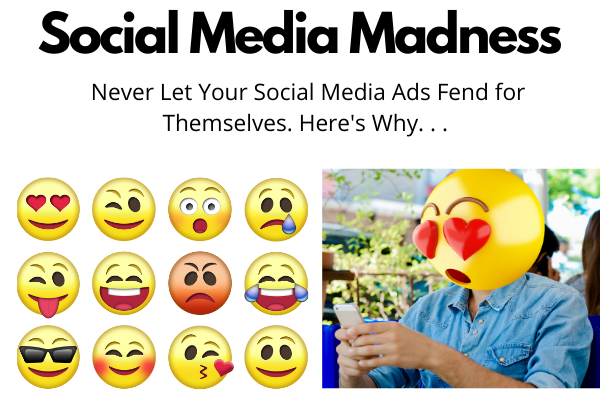Okay, so you have a brilliant marketing strategy right? You’re pounding out ads on social media platforms like Facebook, surely you’ve gotten a lot of conversions on those ads because a lot of people love what you’re doing.
But is something happening under your radar that makes your company look bad? Have you left those ads to fend for themselves like long lost children?
Do you have someone monitoring your ads and replying to comments by prospective consumers and students? If not, you need to see if what
I’m talking about today could be plaguing your posts.
I personally like to read through comments before signing up for a webinar or masterclass. It’s usually amusing at the very least, and it helps me identify the time wasters from legit good free stuff.

One thing I’ve definitely noticed is that for almost every post in the personal transformation field there’s some negative comments out there lingering. Clinging to your ad post each time it’s shared or liked. These comments build up and can help or hurt the reputation of your business and the industry as a whole depending on how or if you choose to respond to them.
It’s inevitable, since you’re going against mainstream ways of thought, that there will be people who chime in their opinion of just exactly what it is that they think you’re doing. Whether they say you’re the Antichrist or you can bring harm by teaching shamanic practices to anyone. Or, how dare you teach healing practices that should only be held by men in high churches?
How is your business responding to these posts? Or, are you responding at all? What do you say to them? I’ll give you some tips on how to respond to these comments and keep your integrity intact. But, first.. I want to rant a little more…
Another issue with these ads is a lack of response to comments on the posts in general. There is a serious lack of response from the companies who put them out there. This is a place where you should be showing up and engaging your target audience.
I’ve literally seen comments on a social media ad post that ask if XYZ Company ever responds. Someone even asked does XYZ Company ever respond? Guess who answered? Well, no one from the company… Other people with comments about how XYZ Company never responds!
Can you imagine having your prospective clients and customers talking about a lack of response from your company among each other? And someone from your company not intervening or saying anything? Not to mention, these comments were from months ago! XYZ Company is losing out on potential customers because no one is responding from the business.
These issues plague so many Facebook ads and cross the line between User Experience into Customer Experience. Circulating social media ads are a leg of your business where potential consumers of your products are mingling and talking about your brand. It’s important for someone from your business to show up there and communicate with them.
If you’re too busy with other items of business to tackle this endeavor, then you might want to consider hiring a social media freelancer who specializes in managing social media accounts for businesses.
In the meantime, I’m going to give you some tips on how you can respond to negative comments on your ads or posts based on insights I’ve gained over my 20 plus years of customer service experience.
Here’s some tips on how to put your best face forward and stop the haters dead in their tracks and show those who are interested in what you offer that you and your employees are examples of the values that your company promotes.
- If you have really old posts circulating with negative unaddressed comments from more than a few months ago, you’re probably best off deleting the whole ad and putting out something new and fresh. Please, don’t put the same post back out there. Come up with something engaging and new.
But, if you do this then it’s important to have someone monitoring these new ads for comments and responding. This is a great opportunity to interact with prospective clients and customers. Plus, you can diffuse comments wishing you ill will with compassion and kindness before they gain ground.
- If the comments are less than a few weeks old, it would be a good idea to comment on them to show you’re monitoring them at least occasionally.
For new negative comments on ad posts here are some sample replies you could use to show that you do value the comments without coming across as harsh and uncaring.
- Hi [insert name], thank you for taking the time to comment on our post. Here at [insert company name], we understand that our ways are not for everyone. We respect your thoughts and opinions and wish you well on your life path. Namaste
- Hi [insert name], thank you for commenting on our post. I’m sorry to hear that you believe [insert name of program] is [insert negative feeling]. Here at [insert company name] we value your beliefs and opinions. We also understand that our ways are not for everyone. If there’s any way we can be of service, please let us know. Many blessings to you.
- Hi [insert name], thank you so much for your comment. We appreciate you taking the time to express your concerns. Here at [insert company name] we take a serious interest in making sure the programs we teach are culturally appropriate. We’d love to hear more about why you think [insert issue] is [insert concern]. Please tell us more about why you feel this way.
Okay, so you don’t need to use these examples exactly as I worded them. Put your own flare to them, so you keep your voice unique to your brand. There are five main things that can help when you’re faced with negative comments or reviews.
- Listen – Listen to and hear what dissatisfied consumers or potential customers are saying. This gives you valuable insight as to the perception of your brand. You can use this information to rethink new marketing campaigns and other areas to help increase engagement.
- Thank – Taking the time to thank someone who comments on your post or ad shows that you value his or her time and opinions. State this clearly.
- Acknowledge – Most of the time, showing that you hear a disgruntled person’s complaints by acknowledging that you heard what that person said or feels will diffuse additional banter or attacks. Many people just want to be heard and acknowledged, especially when they’re feeling upset about something. So, show them that you care about what they have to say by rephrasing their concern back to them.
- Offer Resolution – This can be as simple as asking consumers to tell you more about themselves and their experience with a specific issue. As seen in the third example response. Offering resolution shows that you’re willing to bend and make adjustments if it’s necessary. And, you might benefit from the insights gained by inviting these conversations to take place.
- Best Wishes – No matter what, wish them well. Saying something like “Many blessings” or “best wishes” shows an upset person that you bear them no ill will.
If someone is taking the time to comment on your ads or posts, even if it’s to express how much they hate that what you teach is against their beliefs, chances are they’re interested in or drawn to your programs. But, terrified because it goes against everything they’ve been taught. So, they lash out at you. This is a great opportunity to reassure them they have nothing to be afraid of.
On the other side of the spectrum, you’ll also come across those who have no interest and are just looking for an argument. If this is evident, use a response similar to #1. For example, don’t invite further conversations with someone who just called you the Antichrist. More than likely, you won’t be able to have a reasonable conversation with them.
For the most part, use your best judgment. Don’t engage an angry member of your audience. Simply, thank them for commenting, show you heard them, and if appropriate ask for more information on why they feel the way they do.
Using these tips to spruce up your social media ad posts will draw new clients and students into your classes and webinars. So, do yourself a favor and go out and see what your audience is saying about your ads. I’m interested to hear what you find out.
Namaste, Mindy

